
Last updated on April 22nd, 2025
By October 1, 2025, HUD-assisted properties must implement the NSPIRE standards, a new set of standards for physical inspections of HUD properties. HUD property owners and landlords should familiarize themselves with the new standards and implement the required changes to inspection procedures prior to the October 1 compliance date.
NSPIRE Overview
The NSPIRE Standards, replacing the Uniform Physical Condition Standards (UPCS) and the Housing Quality Standards (HQS), provide a new inspection model for HUD-assisted properties. NSPIRE, standing for the National Standards for the Physical Inspection of Real Estate, aims to improve the quality of HUD housing by focusing on the health, safety, and functionality of HUD properties. To allow HUD programs sufficient time to prepare for NSPIRE implementation, the compliance date for many programs was extended from October 1, 2023 to October 1, 2025. Properties wishing to implement NSPIRE before the compliance date are encouraged to do so, but must notify HUD of their planned transition date.
NSPIRE defines three different inspectable areas of HUD properties: “unit,” “inside,” and “outside.” The “unit” refers to the interior components of a building such as bathrooms, kitchens, carbon monoxide and smoke detectors, ceilings, floors, HVAC units, and lighting. “Inside” refers to common areas within the interior of the building such as basements, community rooms, utility rooms, laundry rooms, halls, stairs, offices, and shared kitchens. Also included under the “inside” category are building systems providing electricity, water, emergency power, etc. “Outside” refers to all building systems and components located outside of the building such as grounds, fences, mailboxes, lighting, parking lots, play areas, roads, walkways, storm drainage, balconies, fire escapes, and roofs. For a complete list of inspectable components, see page 1 of the NSPIRE Standards.
The standards use the terms “life-threatening,” “severe,” “moderate,” and “low” to describe the risk level of deficiencies identified during inspection. NSPIRE specifies the deficiency criteria, health and safety determination, rationale, and correction timeframes for each inspectable component. Life-threatening deficiencies must be addressed within 24 hours, while all other deficiencies must be corrected within 30 days (or a reasonable longer period determined by the PHA).
NSPIRE introduces several new protocols and requirements for property inspections. These include: new requirements for smoke and carbon monoxide alarms, new inspection processes and repair timeframes for infestations, new repair guidelines and timeframes for handrails and guardrails, and new processes and equipment for detecting mold-like substances.
How to Prepare for NSPIRE
According to HUD’s website and the NSPIRE Toolkit Cheat Sheet, landlords and owners of HUD properties can prepare for the upcoming compliance date in the following ways:
- Carefully review the NSPIRE Standards (HUD provides this guide for reading the standards).
- Refer to HUD’s notice on NSPIRE administrative procedures for details on inspection timeframes, preparation, and protocols.
- Review the “Preparing for an NSPIRE Inspection” guide for landlords.
- Train staff on new protocols and requirements.
- Ensure that property profiles and contact information are correct (more details can be found on page 7 of HUD’s notice under “Property Verification and Document Collection”).
- Perform regular preventative maintenance to identify and correct potential issues and hazards.
- Consider resident feedback and respond promptly to resident concerns.
- Utilize HUD’s NSPIRE Toolkit for additional resources, guidance, and training videos.
While you’re busy preparing for the upcoming NSPIRE compliance date, please know that RBT CPAs is here to support all of your accounting, tax, audit, and advisory needs. Reach out to us today and find out how we can be Remarkably Better Together.
